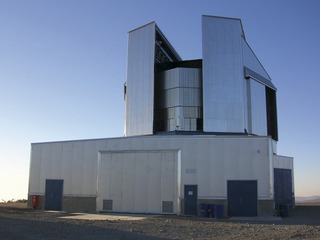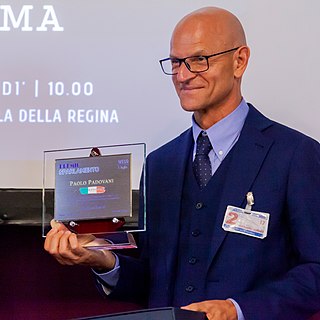
The Very Large Telescope (VLT) is a facility operated by the European Southern Observatory, located on Cerro Paranal in the Atacama Desert of northern Chile. It consists of four individual telescopes, each equipped with a primary mirror that measures 8.2 meters in diameter. These optical telescopes, named Antu, Kueyen, Melipal, and Yepun, are generally used separately but can be combined to achieve a very high angular resolution. The VLT array is also complemented by four movable Auxiliary Telescopes (ATs) with 1.8-meter apertures.

The European Organisation for Astronomical Research in the Southern Hemisphere, commonly referred to as the European Southern Observatory (ESO), is an intergovernmental research organisation made up of 16 member states for ground-based astronomy. Created in 1962, ESO has provided astronomers with state-of-the-art research facilities and access to the southern sky. The organisation employs over 750 staff members and receives annual member state contributions of approximately €162 million. Its observatories are located in northern Chile.

The Atacama Large Millimeter/submillimeter Array (ALMA) is an astronomical interferometer of 66 radio telescopes in the Atacama Desert of northern Chile, which observe electromagnetic radiation at millimeter and submillimeter wavelengths. The array has been constructed on the 5,000 m (16,000 ft) elevation Chajnantor plateau – near the Llano de Chajnantor Observatory and the Atacama Pathfinder Experiment. This location was chosen for its high elevation and low humidity, factors which are crucial to reduce noise and decrease signal attenuation due to Earth's atmosphere. ALMA provides insight on star birth during the early Stelliferous era and detailed imaging of local star and planet formation.

The VISTA is a wide-field reflecting telescope with a 4.1 metre mirror, located at the Paranal Observatory in Chile. It is operated by the European Southern Observatory and started science operations in December 2009. VISTA was conceived and developed by a consortium of universities in the United Kingdom led by Queen Mary University of London and became an in-kind contribution to ESO as part of the UK's accession agreement, with the subscription paid by the UK Science and Technology Facilities Council (STFC).

The New Technology Telescope or NTT is a 3.58-metre Ritchey–Chrétien telescope operated by the European Southern Observatory. It began operations in 1989. It is located in Chile at the La Silla Observatory and was an early pioneer in the use of active optics. The telescope and its enclosure were built to a revolutionary design for optimal image quality.
The Digitized Sky Survey (DSS) is a digitized version of several photographic astronomical surveys of the night sky, produced by the Space Telescope Science Institute between 1983 and 2006.

La Silla Observatory is an astronomical observatory in Chile with three telescopes built and operated by the European Southern Observatory (ESO). Several other telescopes are located at the site and are partly maintained by ESO. The observatory is one of the largest in the Southern Hemisphere and was the first in Chile to be used by ESO.

Paranal Observatory is an astronomical observatory operated by the European Southern Observatory (ESO). It is located in the Atacama Desert of Northern Chile on Cerro Paranal at 2,635 m (8,645 ft) altitude, 120 km (70 mi) south of Antofagasta. By total light-collecting area, it is the largest optical-infrared observatory in the Southern Hemisphere; worldwide, it is second to the Mauna Kea Observatory on Hawaii.

The Extremely Large Telescope (ELT) is an astronomical observatory under construction. When completed, it will be the world's largest optical/near-infrared extremely large telescope. Part of the European Southern Observatory (ESO) agency, it is located on top of Cerro Armazones in the Atacama Desert of northern Chile.

The Space Telescope – European Coordinating Facility (ST-ECF) was an institution which provided a number of support and service functions primarily for European observers of the NASA/ESA Hubble Space Telescope (HST). It was established in 1984 by the European Space Agency (ESA) and the European Southern Observatory (ESO), and was located at the ESO headquarters in Garching bei München, Germany. The ST-ECF ceased operations on 31 December 2010.

The Atacama Pathfinder Experiment (APEX) is a radio telescope 5,064 meters above sea level, at the Llano de Chajnantor Observatory in the Atacama desert in northern Chile, 50 km east of San Pedro de Atacama built and operated by 3 European research institutes. The main dish has a diameter of 12 m and consists of 264 aluminium panels with an average surface accuracy of 17 micrometres (rms). The telescope was officially inaugurated on September 25, 2005.

Astronomical Observatory of Trieste is an astronomical center of studies located in the city of Trieste in northern Italy.

Paolo Padovani is an Italian astronomer working at the European Southern Observatory, specializing in the study of Active galactic nuclei including the study of quasars and blazars, evolution and multifrequency studies and extragalactic backgrounds. In 2004 he and several other astronomers discovered 30 supermassive blackholes at the European Astrophysical Virtual Observatory using pioneering techniques.
Astrovirtel is a data archive used as virtual astronomical observatory. The project was funded from 2000 until 2003 and supported by the European Commission's Access to Research Infrastructures action of the Improving Human Potential Programme and managed by the Space Telescope European Coordinating Facility (ST-ECF) on behalf of European Space Agency and European Southern Observatory (ESO).
The ESO/ST-ECF Science Archive Facility is an electronic archive for astronomical data. It currently contains more than 40.0 Terabytes of scientific data obtained with the ESA/NASA Hubble Space Telescope (HST), with the ESO New Technology Telescope (NTT) and Very Large Telescope (VLT) and with the Wide Field Imager on the ESO/MPI 2.2m Telescope.
Robert (Bob) Fosbury is currently an emeritus astronomer at the European Southern Observatory and an honorary professor at the Institute of Ophthalmology at UCL. He is an astronomer who worked for 26 years at the European Space Agency (ESA) as part of ESA's collaboration with NASA on the Hubble Space Telescope (HST) project at ST-ECF. Based at the European Southern Observatory (ESO) near Munich in Germany, Fosbury joined this initiative in 1985, more than 5 years before launch. During the latter part of this period, Bob served on NASA's Ad Hoc Science Working Group and ESA's Study Science Team as they developed the instrument concepts for the James Webb Space Telescope, the next-generation space observatory.

The Cherenkov Telescope Array or CTA is a multinational, worldwide project to build a new generation of ground-based gamma-ray instrument in the energy range extending from some tens of GeV to about 300 TeV. It is proposed as an open observatory and will consist of two arrays of imaging atmospheric Cherenkov telescopes (IACTs), a first array at the Northern Hemisphere with emphasis on the study of extragalactic objects at the lowest possible energies, and a second array at the Southern Hemisphere, which is to cover the full energy range and concentrate on galactic sources. The physics program of CTA goes beyond high energy astrophysics into cosmology and fundamental physics.

ESPRESSO is a third-generation, fiber fed, cross-dispersed, echelle spectrograph mounted on the European Southern Observatory's Very Large Telescope (VLT). The unit saw its first light on September 25, 2016.

Cerro Armazones Observatory is an international astrophysical project hosted by the ESO Paranal Observatory and operated by the Nicolaus Copernicus Astronomical Center of the Polish Academy of Sciences. The observatory is located on Cerro Murphy, which is a hill located 1 kilometre (0.62 mi) to the southwest and 230 metres (750 ft) below the summit of Cerro Armazones, a mountain in the Antofagasta Region of Chile, 120 km (75 mi) south of Antofagasta. OCM is located at 2,817 m (9,242 ft) altitude and currently houses 5 telescopes, whose diameters range between 0.3 and 1.5 m.

TAROT is a project of the European Southern Observatory (ESO) aimed at rapidly reacting to particular data from other astronomical surveying facilities to monitor for and registering fast changing astronomical objects and phenomena. The target of this particular project is so-called gamma-ray bursts (GRB).
















